2020-03-27 Fri
■ #3987. 古ノルド語の影響があり得る言語項目 (2) [old_norse][contact][syntax][word_order][phrasal_verb][plural][link]
「#1253. 古ノルド語の影響があり得る言語項目」 ([2012-10-01-1]) で挙げたリストに,Dance (1735) を参照し,いくつか項目を追加しておきたい.いずれも実証が待たれる仮説というレベルである.
(1) the marked increase in productivity of the derivational verbal affixes -n- (as in harden, deepen) and -l- (e.g. crackle, sparkle)
(2) the rise of the "phrasal verb" (verb plus adverb/preposition) at the expense of the verbal prefix, most persuasively the development of up in an aspectual (completive) function
(3) certain aspects of v2 syntax (including the development of 'CP-v2' syntax in northern Middle English)
(4) the general shift to VO order
上記 (1) については,「#1877. 動詞を作る接頭辞 en- と接尾辞 -en」 ([2014-06-17-1]) で関連する話題に触れているので,そちらも参照.
(2) については,関連して「#2396. フランス語からの句の借用に対する慎重論」 ([2015-11-18-1]) を参照.
(3), (4) は統語現象だが,とりわけ (4) は大きな仮説である.これについては拙著『英語史で解きほぐす英語の誤解 --- 納得して英語を学ぶために』(中央大学出版部,2011年)の第5章第4節でも論じている.さらに以下の記事やリンク先の話題も合わせてどうぞ.
・ 「#1170. 古ノルド語との言語接触と屈折の衰退」 ([2012-07-10-1])
・ 「#3131. 連載第11回「なぜ英語はSVOの語順なのか?(前編)」」 ([2017-11-22-1]) (連載記事への直接ジャンプはこちら)
・ 「#3160. 連載第12回「なぜ英語はSVOの語順なのか?(後編)」」 ([2017-12-21-1]) (連載記事への直接ジャンプはこちら)
・ 「#3733.『英語教育』の連載第5回「なぜ英語は語順が厳格に決まっているのか」」 ([2019-07-17-1])
最後にリストに加えるのを忘れていたもう1つの項目があった.
(5) the spread of the s-plural
これは,私自身が詳細に論じている説である.詳しくは Hotta をご覧ください.
・ Dance, Richard. "English in Contact: Norse." Chapter 110 of English Historical Linguistics: An International Handbook. 2 vols. Ed. Alexander Bergs and Laurel J. Brinton. Berlin: Mouton de Gruyter, 2012. 1724--37.
・ 堀田 隆一 『英語史で解きほぐす英語の誤解 --- 納得して英語を学ぶために』 中央大学出版部,2011年.
・ Hotta, Ryuichi. The Development of the Nominal Plural Forms in Early Middle English. Tokyo: Hituzi Syobo, 2009.
2020-03-22 Sun
■ #3982. 古ノルド語借用語の音韻的特徴 [old_norse][loan_word][borrowing][phonology][cognate][doublet][palatalisation][link]
標題と関連して,Durkin (191--92) が挙げている古ノルド語借用語の例を挙げる.左列が古英語の同根語,中列が古ノルド語の同根語(かつ現代英語に受け継がれた語),右列が参考までに古アイスランド語での語形である.とりわけ左列と中列の音韻形態を比較してもらいたい.
| OE | Scandinavian | Cf. Old Icelandic |
|---|---|---|
| sċyrta (> shirt) | skirt | skyrta |
| sċ(e)aða, sċ(e)aðian | scathe | skaði, skaða 'it hurts' |
| sċiell, sċell (> shell) | (northern) skell 'shell' | skel |
| ċietel, ċetel (> ME chetel) | kettle | ketill |
| ċiriċe (> church) | (northern) kirk | kirkja |
| ċist, ċest (> chest) | (northern) kist | kista |
| ċeorl (> churl) | (northern) carl | karl |
| hlenċe | link | hlekkr |
| ġietan | get | geta |
| ġiefan | give | geva (OSw. giva) |
| ġift | gift | gipt (OSw. gipt, gift) |
| ġeard (> yard) | (northern) garth | garðr |
| ġearwe | gear | gervi |
| bǣtan | bait 'to bait' | beita |
| hāl (> whole) | hail 'healthy' | heill |
| lāc | northern laik 'game' | leikr |
| rǣran (> rear) | raise | reisa |
| swān | swain | sveinn |
| nā (> no) | nay | nei |
| blāc | bleak | bleikr |
| wāc | weak | veikr |
| þēah | though | þó |
| lēas | loose | louss, lauss |
| ǣġ (> ME ei) | egg | egg |
| sweoster, swuster | sister | systir |
| fram, from (> from) | fro | frá |
古英語形と古ノルド語形について,いくつか特徴的な音韻対応が浮かび上がってくる.これらは,共通祖語から分かれた後に各言語で独自の音韻変化が生じた結果としての音韻対応である.その音韻変化に注目して箇条書きしよう (Durkin 193--98) .
(1) 古英語では /sk/ > /ʃ/ が起こっているが,古ノルド語では起こっていない
(2) 古英語では /k/ > /tʃ/ が起こっているが,古ノルド語では起こっていない
(3) 古英語では /g/ > /j/ と /gg/ > /ddʒ/ が起こっているが,古ノルド語では起こっていない
(4) 古英語ではゲルマン祖語の *ai > ā が起こったが,古ノルド語では起こっていない
(5) 古英語ではゲルマン祖語の *au > ēa が起こったが,古ノルド語では起こっていない
(6) 古ノルド語では *jj > gg が起こっているが,古英語では起こっていない
(7) 古ノルド語では *ui > y が起こっているが,古英語では起こっていない
(8) 古ノルド語では語末の鼻音が消失したが,古英語では消失していない
音韻変化には条件のつくものが多いので,上記ですべてをきれいに説明できるわけではないが,知っておくと現代英語の語形に関する様々な謎が解きやすくなる.関連する記事を挙げておこう.
・ 「#2730. palatalisation」 ([2016-10-17-1])
・ 「#1511. 古英語期の sc の口蓋化・歯擦化」 ([2013-06-16-1])
・ 「#2015. seek と beseech の語尾子音」 ([2014-11-02-1])
・ 「#2054. seek と beseech の語尾子音 (2)」 ([2014-12-11-1])
・ 「#40. 接尾辞 -ly は副詞語尾か?」 ([2009-06-07-1])
・ 「#170. guest と host」 ([2009-10-14-1])
・ 「#169. get と give はなぜ /g/ 音をもっているのか」 ([2009-10-13-1])
・ 「#3817. hale の語根ネットワーク」 ([2019-10-09-1])
・ 「#3699. なぜ careless の反対は *caremore ではなくcareful なのですか?」 ([2019-06-13-1])
・ 「#337. egges or eyren」 ([2010-03-30-1])
・ Durkin, Philip. Borrowed Words: A History of Loanwords in English. Oxford: OUP, 2014.
2020-03-17 Tue
■ #3977. 講座「英語の歴史と語源」の第6回「ヴァイキングの侵攻」のご案内 [asacul][notice][old_norse][history][oe][anglo-saxon][borrowing][contact][loan_word][link]
今週末の3月21日(土)の15:15?18:30に,朝日カルチャーセンター新宿教室にて「英語の歴史と語源・6 ヴァイキングの侵攻」と題する講演を行ないます.趣旨は以下の通りです.
8世紀後半,アングロサクソン人はヴァイキングの襲撃を受けました.現在の北欧諸語の祖先である古ノルド語を母語としていたヴァイキングは,その後イングランド東北部に定住しましたが,その地で古ノルド語と英語は激しく接触することになりました.こうして古ノルド語の影響下で揉まれた英語は語彙や文法において大きく変質し,その痕跡は現代英語にも深く刻まれています.ヴァイキングがいなかったら,現在の英語の姿はないのです.今回は,ヴァイキングの活動と古ノルド語について概観しつつ,言語接触一般の議論を経た上で,英語にみられる古ノルド語の語彙的な遺産に注目します.
ヴァイキングや古ノルド語 (old_norse) について,本ブログでも関連する話題を多く扱ってきました.以下,主要な記事にリンクを張っておきます.
・ 「#59. 英語史における古ノルド語の意義を教わった!」 ([2009-06-26-1])
・ 「#111. 英語史における古ノルド語と古フランス語の影響を比較する」 ([2009-08-16-1])
・ 「#169. get と give はなぜ /g/ 音をもっているのか」 ([2009-10-13-1])
・ 「#170. guest と host」 ([2009-10-14-1])
・ 「#340. 古ノルド語が英語に与えた影響の Jespersen 評」 ([2010-04-02-1])
・ 「#818. イングランドに残る古ノルド語地名」 ([2011-07-24-1])
・ 「#827. she の語源説」 ([2011-08-02-1])
・ 「#881. 古ノルド語要素を南下させた人々」 ([2011-09-25-1])
・ 「#931. 古英語と古ノルド語の屈折語尾の差異」 ([2011-11-14-1])
・ 「#1146. インドヨーロッパ語族の系統図(Fortson版)」 ([2012-06-16-1])
・ 「#1167. 言語接触は平時ではなく戦時にこそ激しい」 ([2012-07-07-1])
・ 「#1170. 古ノルド語との言語接触と屈折の衰退」 ([2012-07-10-1])
・ 「#1179. 古ノルド語との接触と「弱い絆」」 ([2012-07-19-1])
・ 「#1182. 古ノルド語との言語接触はたいした事件ではない?」 ([2012-07-22-1])
・ 「#1183. 古ノルド語の影響の正当な評価を目指して」 ([2012-07-23-1])
・ 「#1253. 古ノルド語の影響があり得る言語項目」 ([2012-10-01-1])
・ 「#1611. 入り江から内海,そして大海原へ」 ([2013-09-24-1])
・ 「#1937. 連結形 -son による父称は古ノルド語由来」 ([2014-08-16-1])
・ 「#1938. 連結形 -by による地名形成は古ノルド語のものか?」 ([2014-08-17-1])
・ 「#2354. 古ノルド語の影響は地理的,フランス語の影響は文体的」 ([2015-10-07-1])
・ 「#2591. 古ノルド語はいつまでイングランドで使われていたか」 ([2016-05-31-1])
・ 「#2625. 古ノルド語からの借用語の日常性」 ([2016-07-04-1])
・ 「#2692. 古ノルド語借用語に関する Gersum Project」 ([2016-09-09-1])
・ 「#2693. 古ノルド語借用語の統計」 ([2016-09-10-1])
・ 「#2869. 古ノルド語からの借用は古英語期であっても,その文証は中英語期」 ([2017-03-05-1])
・ 「#2889. ヴァイキングの移動の原動力」 ([2017-03-25-1])
・ 「#3001. なぜ古英語は古ノルド語に置換されなかったのか?」 ([2017-07-15-1])
・ 「#3263. なぜ古ノルド語からの借用語の多くが中英語期に初出するのか?」 ([2018-04-03-1])
・ 「#3969. ラテン語,古ノルド語,ケルト語,フランス語が英語に及ぼした影響を比較する」 ([2020-03-09-1])
・ 「#3972. 古英語と古ノルド語の接触の結果は koineisation か?」 ([2020-03-12-1])
・ 「#3606. 講座「北欧ヴァイキングと英語」」 ([2019-03-12-1])
2020-03-16 Mon
■ #3976. 英語史における黒死病の意義 [black_death][link][reestablishment_of_english]
新型コロナウィルス (COVID-19) が世界中で大流行しています.一刻も早く事態が終息することを願っています.英語史ブログ運営者としては,この時節に及んで中世ヨーロッパにもたらされた災禍である黒死病 (black_death) に触れないわけにはいきません.あえてこの話題を取り上げる次第です.
とはいえ,新しいことは何もありません.本ブログでは,英語史における黒死病の意義についてすでに多くの記事で検討してきました.以下にリンクを張りましたので,ぜひ関連する記事をご一読ください.とりわけお薦めは「#3058. 「英語史における黒死病の意義」のまとめスライド」 ([2017-09-10-1]) です.これは,2017年9月2日に朝日カルチャーセンター新宿教室で開いた「講座 歴史の動きと英語の変化」の第3回として「黒死病と英語」の題目の下で話した内容にもとづいています.エッセンスのみを記載していますが,ポイントは押さえているはずです.
・ 「#119. 英語を世界語にしたのはクマネズミか!?」 ([2009-08-24-1])
・ 「#139. 黒死病と英語復権の関係について再々考」 ([2009-09-13-1])
・ 「#144. 隔離は40日」 ([2009-09-18-1])
・ 「#1206. 中世イングランドにおける英語による教育の始まり」 ([2012-08-15-1])
・ 「#2990. Black Death」 ([2017-07-04-1])
・ 「#3053. 黒死病により農奴制から自由農民制へ」 ([2017-09-05-1])
・ 「#3054. 黒死病による社会の流動化と諸方言の水平化」 ([2017-09-06-1])
・ 「#3055. 黒死病による聖職者の大量死」 ([2017-09-07-1])
・ 「#3056. 黒死病による人口減少と技術革新」 ([2017-09-08-1])
・ 「#3057. "The Pardoner's Tale" にみる黒死病」 ([2017-09-09-1])
・ 「#3058. 「英語史における黒死病の意義」のまとめスライド」 ([2017-09-10-1])
・ 「#3061. 誤用と正用という観念の発現について」 ([2017-09-13-1])
・ 「#3062. 1665年のペストに関する Samuel Pepys の記録」 ([2017-09-14-1])
・ 「#3065. 都市化,疫病,言語交替」 ([2017-09-17-1])
・ 「#3196. 中英語期の主要な出来事の年表」 ([2018-01-26-1])
・ 「#3212. 黒死病,死の舞踏,memento mori」 ([2018-02-11-1])
・ 「#3780. Foley による「標準英語の発展」の記述」 ([2019-09-02-1])
1348年に初めてイギリスに飛び火した黒死病は,1066年のノルマン征服により下落していた英語の地位を回復するのにあずかって大きかったとするのが英語史の通説です.逆にいえば,もし黒死病が起こらなかったらば,英語は近代の入り口までにイングランドの国語としての地位を回復できなかった,あるいは回復したとしてももっと遅かっただろうという結論になります.さらに想像力をたくましくすれば,後の英語の世界的展開もなかった,あるいは遅れた,あるいは異なる形をとっていた,ということにもなり得ます.そうであれば,読者の皆さんも英語など学んでいなかったかもしれませんし,この英語史ブログも存在しなかったかもしれません.
上記の通説は英語史の一面を正しくとらえた説であると私も考えています.一方で黒死病の流行は世界史上著名な事件としてあまりによく知られているだけに,その効果や意義が過大評価されやすいという側面もあるのではないかと(自戒を込めて)考えています.英語復権 (reestablishment_of_english) の歩みは,ノルマン征服直後より始まっており,その後ゆっくりとではあるものの着実に進んでいたというのが歴史的事実です.黒死病はそのような従来の緩慢な傾向に,14世紀半ばというタイミングで拍車をかけたということでしょう.黒死病は英語の復権に一役買ったとはいえ,あくまで多数の要因の1つだったという解釈が妥当でしょう.
では,その他の多数の要因とは何でしょうか.これについては,英語の復権に関する reestablishment_of_english の記事群を読んでいただければと思います.そのなかでとりわけ重要な記事にのみ,以下にリンクを張っておきます.
・ 「#131. 英語の復権」 ([2009-09-05-1])
・ 「#138. 黒死病と英語復権の関係について再考」 ([2009-09-12-1])
・ 「#139. 黒死病と英語復権の関係について再々考」 ([2009-09-13-1])
・ 「#706. 14世紀,英語の復権は徐ろに」 ([2011-04-03-1])
・ 「#1207. 英語の書き言葉の復権」 ([2012-08-16-1])
・ 「#1821. フランス語の復権と英語の復権」 ([2014-04-22-1])
・ 「#2334. 英語の復権と議会の発展」 ([2015-09-17-1])
・ 「#3058. 「英語史における黒死病の意義」のまとめスライド」 ([2017-09-10-1])
・ 「#3894. 「英語復権にプラス・マイナスに貢献した要因」の議論がおもしろかった」 ([2019-12-25-1])
2020-03-13 Fri
■ #3973. 『ビジュアル数学全史』の英語目次 [mathematics][toc][review][link]
数学に関する年表・図鑑・事典が一緒になったような,それでいて読み物として飽きない『ビジュアル数学全史』を通読した.2009年の原著 The Math Book の邦訳である.250の話題の各々について写真や図形が添えられており,雑学ネタにも事欠かない.ゾクゾクさせる数の魅力にはまってしまった.この本の公式HPはこちら.
原著で読んでいたら数学用語にも強くなっていたかもしれないと思ったが,250のキーワードについては英語版の目次から簡単に拾える.ということで,以下に日英両言語版の目次をまとめてみた.ただ挙げるのでは芸がないので,本ブログの過去の記事と引っかけられそうなキーワードについては,リンクを張っておいた.数学(を含む自然科学)に関連する言語学・英語学・英語史の話題については,たまに取り上げてきたので.
1. アリの体内距離計:Ant Odometer (c. 150 million BC)
2. 数をかぞえる霊長類:Primates Count (c. 30 million BC)
3. セミと素数:Cicada-Generated Prime Numbers (c. 1 million BC)
4. 結び目:Knots (c. 100,000 BC)
5. イシャンゴ獣骨:Ishango Bone (c. 18,000 BC)
6. キープ:Quipu (c. 3000 BC) (cf. 「#2389. 文字体系の起源と発達 (1)」 ([2015-11-11-1]),「#3838. 「文字を有さずとも,かなり高度な文明と文化をつくり上げることは可能」」 ([2019-10-30-1]))
7. サイコロ:Dice (c. 3000 BC)
8. 魔方陣:Magic Squares (c. 2200 BC)
9. プリンプトン322:Plimpton 322 (c. 1800 BC)
10. リンド・パピルス:Rhind Papyrus (c. 1650 BC)
11. 三目並べ:Tic Tac Toe (c. 1300 BC)
12. ピタゴラスの定理とピタゴラス三角形:Pythagorean Theorem and Triangles (c. 600 BC)
13. 囲碁:Go (548 BC)
14. ピタゴラス教団の誕生:Pythagoras Founds Mathematical Brotherhood (530 BC)
15. ゼノンのパラドックス:Zeno's Paradoxes (c. 445 BC)
16. 弓形の求積法:Quadrature of the Lune (c. 440 BC)
17. プラトンの立体:Platonic Solids (350 BC)
18. アリストテレスの『オルガノン』:Aristotle's Organon (c. 350 BC)
19. アリストテレスの車輪のパラドックス:Aristotle's Wheel Paradox (c. 320 BC)
20. ユークリッドの『原論』:Euclid's Elements (300 BC)
21. アルキメデスの『砂粒』『牛』『ストマキオン』:Archimedes: Sand, Cattle & Stomachion (c. 250 BC)
22. 円周率 π:pi (c. 250 BC)
23. エラトステネスのふるい:Sieve of Eratosthenes (c. 240 BC)
24. アルキメデスの半正多面体:Archimedean Semi-Regular Polyhedra (c. 240 BC)
25. アルキメデスのらせん:Archimedes' Spiral (225 BC)
26. ディオクレスのシッソイド:Cissoid of Diocles (c. 180 BC)
27. プトレマイオスの『アルマゲスト』:Ptolemy's Almagest (c. 150)
28. ディオファントスの『算術』:Diophantus's Arithmetica (250)
29. パッポスの六角形定理:Pappus's Hexagon Theorem (c. 340)
30. バクシャーリー写本:Bakhshali Manuscript (c. 350)
31. ヒュパティアの死:The Death of Hypatia (415)
32. ゼロ:Zero (c. 650)
33. アルクィンの『青年たちを鍛えるための諸命題』:Alcuin's Propositiones ad Acuendos Juvenes (c. 800) (cf. 「#1309. 大文字と小文字」 ([2012-11-26-1]),「#2871. 古英語期のスライド年表」 ([2017-03-07-1]),「#3820. なぜアルフレッド大王の時代までに学問が衰退してしまったのか?」 ([2019-10-12-1]))
34. アル=フワーリズミーの『代数学』:al-Khwarizmi's Algebra (830) (cf. 「#2918. 「未知のもの」を表わす x」 ([2017-04-23-1]))
35. ボロミアン環:Borromean Rings (834)
36. 『ガニタサーラサングラハ』:Ganita Sara Samgraha (850)
37. サービトの友愛数の公式:Thabit Formula for Amicable Numbers (c. 850)
38. 『算術について(インド式計算について諸章よりなる書)』:Kitab al-fusul fi al-hisab al-Hindi (c. 953)
39. オマル・ハイヤームの『代数学』:Omar Khayyam's Treatise (1070)
40. アッ=サマウアルの『代数の驚嘆』:Al-Samawal's The Dazzling (c. 1150)
41. そろばん:Abacus (c. 1200)
42. フィボナッチの『計算の書』:Fibonacci's Liber Abaci (1202)
43. チェス盤上の麦粒:Wheat on a Chessboard (1256)
44. 調和級数の発散:Harmonic Series Diverges (c. 1350)
45. 余弦定理:Law of Cosines (c. 1427)
46. 『トレヴィーゾ算術書』:Treviso Arithmetic (1478)
47. 円周率の級数公式の発見:Discovery of Series Formula for Pi (c. 1500)
48. 黄金比:Golden Ratio (1509)
49. 『ポリグラフィア』:Polygraphiae Libri Sex (1518)
50. 航程線:Loxodrome (1537)
51. カルダノの『アルス・マグナ』:Cardano's Ars Magna (1545)
52. 『スマリオ・コンペンディオソ』:Sumario Compendioso (1556)
53. メルカトール図法:Mercator Projection (1569)
54. 虚数:Imaginary Numbers (1572) (cf. 「#2120. 再建形は虚数である」 ([2015-02-15-1]))
55. ケプラー予想:Kepler Conjecture (1611)
56. 対数:Logarithms (1614)
57. 計算尺:Slide Rule (1621)
58. フェルマーのらせん:Fermat's Spiral (1636)
59. フェルマーの最終定理:Fermat's Last Theorem (1637)
60. デカルトの『幾何学』:Descartes' La Geometrie (1637)
61. カージオイド:Cardioid (1637)
62. 対数らせん:Logarithmic Spiral (1638)
63. 射影幾何学:Projective Geometry (1639)
64. トリチェリのトランペット:Torricelli's Trumpet (1641)
65. パスカルの三角形:Pascal's Triangle (1654)
66. ニールの放物線:The Length of Neile's Semicubical Parabola (1657)
67. ヴィヴィアーニの定理:Viviani's Theorem (1659)
68. 微積分の発見:Discovery of Calculus (c. 1665)
69. ニュートン法:Newton's Method (1669)
70. 等時曲線問題:Tautochrone Problem (1673)
71. 星芒形:Astroid (1674)
72. ロピタルの『無限小解析』:L'Hopital's Analysis of the Infinitely Small (1696)
73. 地球を取り巻くロープのパズル:Rope around the Earth Puzzle (1702)
74. 大数の法則:Law of Large Numbers (1713)
75. オイラー数 e:Euler's Number, e (1727)
76. スターリングの公式:Stirling's Formula (1730)
77. 正規分布曲線:Normal Distribution Curve (1733)
78. オイラー・マスケローニの定数:Euler-Mascheroni Constant (1735)
79. ケーニヒスベルクの橋渡り:Konigsberg Bridges (1736)
80. サンクトペテルブルクのパラドックス:St. Petersburg Paradox (1738)
81. ゴールドバッハ予想:Goldbach Conjecture (1742)
82. アニェージの『解析教程』:Agnesi's Instituzioni Analitiche (1748)
83. オイラーの多面体公式:Euler's Formula for Polyhedra (1751)
84. オイラーの多角形分割問題:Euler's Polygon Division Problem (1751)
85. 騎士巡回問題:Knight's Tours (1759)
86. ベイズの定理:Bayes' Theorem (1761)
87. フランクリン魔方陣:Franklin Magic Square (1769)
88. 極小曲面:Minimal Surface (1774)
89. ビュフォンの針:Buffon's Needle (1777)
90. 36人の士官の問題:Thirty-Six Officers Problem (1779)
91. 算額の幾何学:Sangaku Geometry (c. 1789)
92. 最小二乗法:Least Squares (1795)
93. 正十七角形の作図:Constructing a Regular Heptadecagon (1796)
94. 代数学の基本定理:Fundamental Theorem of Algebra (1797)
95. ガウスの『数論考究』:Gauss's Disquisitiones Arithmeticae (1801)
96. 三桿分度器:Three-Armed Protractor (1801)
97. フーリエ級数:Fourier Series (1807)
98. ラプラスの『確率の解析的理論』:Laplace's Theorie Analytique des Probabilites (1812)
99. ルパート公の問題:Prince Rupert's Problem (1816)
100. ベッセル関数:Bessel Functions (1817)
101. バベッジの機械式計算機:Babbage Mechanical Computer (1822)
102. コーシーの『微分積分学要論』:Cauchy's Le Calcul Infinitesimal (1823)
103. 重心計算:Barycentric Calculus (1827)
104. 非ユークリッド幾何学:Non-Euclidean Geometry (1829)
105. メビウス関数:Mobius Function (1831)
106. 群論:Group Theory (1832)
107. 鳩の巣原理:Pigeonhole Principle (1834)
108. 四元数:Quaternions (1843)
109. 超越数:Transcendental Numbers (1844)
110. カタラン予想:Catalan Conjecture (1844)
111. シルヴェスターの行列:The Matrices of Sylvester (1850)
???112. ?????峨?????鐚?Four-Color Theorem (1852)
113. ブール代数:Boolean Algebra (1854)
114. イコシアン・ゲーム:Icosian Game (1857)
115. ハーモノグラフ:Harmonograph (1857)
116. メビウスの帯:The Mobius Strip (1858)
117. ホルディッチの定理:Holditch's Theorem (1858)
118. リーマン予想:Riemann Hypothesis (1859)
119. ベルトラミの擬球面:Beltrami's Pseudosphere (1868)
120. ワイエルシュトラース関数:Weierstrass Function (1872)
121. グロの『チャイニーズリングの理論』:Gros's Theorie du Baguenodier (1872)
122. コワレフスカヤの博士号:The Doctorate of Kovalevskaya (1874)
123. 15パズル:Fifteen Puzzle (1874)
124. カントールの超限数:Cantor's Transfinite Numbers (1874)
125. ルーローの三角形:Reuleaux Triangle (1875)
126. 調和解析機:Harmonic Analyzer (1876)
127. リッティ・モデルIキャッシュレジスター:Ritty Model I Cash Register (1879)
128. ベン図:Venn Diagrams (1880)
129. ベンフォードの法則:Benford's Law (1881)
130. クラインのつぼ:Klein Bottle (1882)
131. ハノイの塔:Tower of Hanoi (1883)
132. フラットランド:Flatland (1884)
133. 四次元立方体:Tesseract (1888)
134. ペアノの公理:Peano Axioms (1889)
135. ペアノ曲線:Peano Curve (1890)
136. 壁紙群:Wallpaper Groups (1891)
137. シルヴェスターの直線の問題:Sylvester's Line Problem (1893)
138. 素数定理の証明:Proof of the Prime Number Theorem (1896)
139. ピックの定理:Pick's Theorem (1899)
140. モーリーの三等分線定理:Morley's Trisector Theorem (1899)
141. ヒルベルトの23の問題:Hilbert's 23 Problems (1900)
142. カイ二乗検定:Chi-Square (1900) (cf. 「#696. Log-Likelihood Test」 ([2011-03-24-1]))
143. ボーイ曲面:Boy's Surface (1901)
144. 床屋のパラドックス:Barber Paradox (1901)
145. ユングの定理:Jung's Theorem (1901)
146. ポアンカレ予想:Poincare Conjecture (1904)
147. コッホ雪片:Koch Snowflake (1904)
148. ツェルメロの選択公理:Zermelo's Axiom of Choice (1904)
149. ジョルダン曲線定理:Jordan Curve Theorem (1905)
150. トゥーエ-モース数列:Thue-Morse Sequence (1906)
151. ブラウアーの不動点定理:Brouwer Fixed-Point Theorem (1909)
152. 正規数:Normal Number (1909)
153. ブールの『代数の哲学と楽しみ』:Boole's Philosophy and Fun of Algebra (1909)
154. 『プリンキピア・マテマティカ』:Principia Mathematica (1910-1913)
155. 毛玉の定理:Hairy Ball Theorem (1912)
156. 無限の猿定理:Infinite Monkey Theorem (1913)
157. ビーベルバッハ予想:Bieberbach Conjecture (1916)
158. ジョンソンの定理:Johnson's Theorem (1916)
159. ハウスドルフ次元:Hausdorff Dimension (1918)
160. ブルン定数:Brun's Constant (1919)
161. グーゴル:Googol (c. 1920) (cf. 「#888. 語根創成について一考」 ([2011-10-02-1]))
162. アントワーヌのネックレス:Antoine's Necklace (1920)
163. ネーターの『イデアル論』:Noether's Idealtheorie (1921)
164. 超空間で迷子になる確率:Lost in Hyperspace (1921)
165. ジオデシック・ドーム:Geodesic Dome (1922)
166. アレクサンダーの角付き球面:Alexander's Horned Sphere (1924)
167. バナッハ-タルスキのパラドックス:Banach-Tarski Paradox (1924)
168. 長方形の正方分割:Squaring a Rectangle (1925)
169. ヒルベルトのグランドホテル:Hilbert's Grand Hotel (1925)
170. メンガーのスポンジ:Menger Sponge (1926)
171. 微分解析機:Differential Analyzer (1927)
172. ラムゼー理論:Ramsey Theory (1928)
173. ゲーデルの定理:Godel's Theorem (1931)
174. チャンパノウン数:Champernowne's Number (1933)
175. 秘密結社ブルバキ:Bourbaki: Secret Society (1935)
176. フィールズ賞:Fields Medal (1936)
177. チューリングマシン:Turing Machines (1936)
178. フォーデルベルクのタイリング:Voderberg Tilings (1936)
179. コラッツ予想:Collatz Conjecture (1937)
180. フォードの円:Ford Circles (1938)
181. 乱数発生器の発達:The Rise of Randomizing Machines (1938)
182. 誕生日のパラドックス:Birthday Paradox (1939)
183. 外接多角形:Polygon Circumscribing (c. 1940)
184. ボードゲーム「ヘックス」:Hex (1942)
185. ピッグ・ゲームの戦略:Pig Game Strategy (1945)
186. ENIAC:ENIAC (1946) (cf. 「#889. acronym の20世紀」 ([2011-10-03-1]))
187. フォン・ノイマンの平方採中法:Von Neumann's Middle-Square Randomizer (1946)
188. グレイコード:Gray Code (1947)
189. 情報理論:Information Theory (1948) (cf. information_theory)
190. クルタ計算機:Curta Calculator (1948)
191. チャーサール多面体:Csaszar Polyhedron (1949)
192. ナッシュ均衡:Nash Equilibrium (1950)
193. 海岸線のパラドックス:Coastline Paradox (c. 1950)
194. 囚人のジレンマ:Prisoner's Dilemma (1950)
195. セル・オートマトン:Cellular Automata (1952)
196. マーティン・ガードナーの数学レクリエーション:Martin Gardner's Mathematical Recreations (1957)
197. ギルブレスの予想:Gilbreath's Conjecture (1958)
198. 球面の内側と外側をひっくり返す:Turning a Sphere Inside Out (1958)
199. プラトンのビリヤード:Platonic Billiards (1958)
200. 外接ビリヤード:Outer Billiards (1959)
201. ニューコムのパラドックス:Newcomb's Paradox (1960)
202. シェルピンスキ数:Sierpinski Numbers (1960)
203. カオスとバタフライ効果:Chaos and the Butterfly Effect (1963) (cf. chaos_theory)
204. ウラムのらせん:Ulam Spiral (1963)
205. 連続体仮説の非決定性:Continuum Hypothesis Undecidability (1963)
206. スーパーエッグ:Superegg (c. 1965)
207. ファジィ論理:Fuzzy Logic (1965)
208. インスタント・インサニティ:Instant Insanity (1966)
209. ラングランズ・プログラム:Langlands Program (1967)
210. スプラウト・ゲーム:Sprouts (1967)
211. カタストロフィー理論:Catastrophe Theory (1968)
212. トカルスキーの照らし出せない部屋:Tokarsky's Unilluminable Room (1969)
213. ドナルド・クヌースとマスターマインド:Donald Knuth and Mastermind (1970)
214. エルデーシュの膨大な共同研究:Erdos and Extreme Collaboration (1971)
215. 最初の関数電卓HP-35:HP-35: First Scientific Pocket Calculator (1972)
216. ペンローズ・タイル:Penrose Tiles (1973)
217. 美術館定理:Art Gallery Theorem (1973)
218. ルービック・キューブ:Rubik's Cube (1974)
219. チャイティンのオメガ:Chaitin's Omega (1974)
???220. 莇??憜????逸??Surreal Numbers (1974)
221. ペルコの結び目:Perko Knots (1974)
222. フラクタル:Fractals (1975) (cf. 「#3123. カオスとフラクタル」 ([2017-11-14-1]))
223. ファイゲンバウム定数:Feigenbaum Constant (1975)
224. 公開鍵暗号:Public-Key Cryptography (1977) (cf. 「#2699. 暗号学と言語学」 ([2016-09-16-1]),cat('cryptology'))
225. シラッシ多面体:Szilassi Polyhedron (1977)
226. 池田アトラクター:Ikeda Attractor (1979) (cf. 「#3111. カオス理論と言語変化 (1)」 ([2017-11-02-1]),「#3123. カオスとフラクタル」 ([2017-11-14-1]))
227. スパイドロン:Spidrons (1979)
228. マンデルブロー集合:Mandelbrot Set (1980) (cf. 「#3123. カオスとフラクタル」 ([2017-11-14-1]),「#3132. 暗号学と言語学 (2)」 ([2017-11-23-1]))
229. モンスター群:Monster Group (1981)
230. n次元球体内の三角形:Ball Triangle Picking (1982)
231. ジョーンズ多項式:Jones Polynomial (1984)
232. ウィークス多様体:Weeks Manifold (1985)
233. アンドリカの予想:Andrica's Conjecture (1985)
???234. ABC篋???鰹??The ABC Conjecture (1985)
235. 読み上げ数列:Audioactive Sequence (1986)
???236. Mathematica鐚?Mathematica (1988)
237. マーフィーの法則と結び目:Murphy's Law and Knots (1988)
238. バタフライ曲線:Butterfly Curve (1989)
239. オンライン整数列大辞典:The On-Line Encyclopedia of Integer Sequences (1996)
240. エターニティ・パズル:Eternity Puzzle (1999)
241. 四次元完全魔方陣:Perfect Magic Tesseract (1999)
242. パロンドのパラドックス:Parrondo's Paradox (1999)
243. ホリヘドロンの解決:Solving of the Holyhedron (1999)
244. ベッドシーツ問題:Bed Sheet Problem (2001)
245. オワリ・ゲームの解決:Solving the Game of Awari (2002)
246. テトリスはNP完全:Tetris is NP-Complete (2002)
247. 天才数学者の事件ファイル:NUMB3RS (2005)
248. チェッカーの解決:Checkers is Solved (2007)
249. 例外型単純リー群E8の探求:The Quest for Lie Group E8 (2007)
250. 数学的宇宙仮説:Mathematical Universe Hypothesis (2007)
・ Pickover, Clifford A. The Math Book: From Pythagoras to the 57th Dimension, 250 Milestones in the History of Mathematics. New York: Sterling, 2009.
・ ピックオーバー,クリフォード(著),根上 生也・水原 文(訳) 『ビジュアル数学全史』 岩波書店,2017年.
[ 固定リンク | 印刷用ページ ]
2020-02-20 Thu
■ #3951. 現代英語において /h/ の分布はむしろ拡がっている? [h][consonant][phonotactics][spanish][link][ame]
英語の歴史において /h/ という子音音素の位置づけが不安定だったことについて,最近では「#3936. h-dropping 批判とギリシア借用語」 ([2020-02-05-1]),「#3938. 語頭における母音の前の h ばかりが問題視され,子音の前の h は問題にもされなかった」 ([2020-02-07-1]),「#3945. "<h> second" の2重字の起源と発達」 ([2020-02-14-1]) で触れてきた.過去にも以下の記事をはじめとして h の記事で話題にしてきた.
・ 「#214. 不安定な子音 /h/」 ([2009-11-27-1])
・ 「#459. 不安定な子音 /h/ (2)」 ([2010-07-30-1])
・ 「#1677. 語頭の <h> の歴史についての諸説」 ([2013-11-29-1])
・ 「#1292. 中英語から近代英語にかけての h の位置づけ」 ([2012-11-09-1])
・ 「#1675. 中英語から近代英語にかけての h の位置づけ (2)」 ([2013-11-27-1])
・ 「#1899. 中英語から近代英語にかけての h の位置づけ (3)」 ([2014-07-09-1])
では,現代英語において問題の /h/ はどのくらい不安定なのか.標準英語から一歩離れれば Cockney を含む多くの変種で /h/ の存在が危ういという現実を知れば,不安定さは昔も今もさほど変わっていないだろうと想像されるが,そうでもないらしい.Minkova (115) は,むしろ /h/ が生起する音環境は拡がっているという事実があるという.歴史的には /h/ は原則として強勢のある語幹頭にしか現われなかったが,今やそれ以外の環境でも現われるようになっているという.しかも,この分布の拡大に貢献している要因の1つが,なんと /h/ をもたないはずのスペイン語だというのだから驚く.しかし,解説を読めば納得できる.
The overall picture is clear: in native words /h-/ remains stable only if it forms the single onset of a stressed syllable, which is tantamount to saying that in the native vocabulary this consonant is historically restricted to stem-initial position. The distribution of /h-/ is broadening, however. In the last century, Spanish-English bilingualism in the American Southwest has resulted in the formation of new varieties of Latino Englishes, which in their turn influence AmE. One such influence results in the acceptability of stem-internal /h-/, as in jojoba, mojo, fajita. Also ... /h-/ is retained in borrowings in the onset of unstressed syllables: rioha (1611), alóha (1825), mája (1832), fáham 'an orchid native to Mauritius' (1850), an it is formed natively as in Soho (1818), colloquial AmE doohickey [ˈduːhɪkɪ], yeehaw [ˈjiːhɑ], most recently the blend WeHo [ˈwiːhoʊ] 'West Hollywood' (2006).
英語がスペイン語の <j> ≡ /x/ を取り込むときに,英語の音素として存在しない /x/ の代わりに,聴覚印象の近い /h/ で取り込む習慣があるから,というのが答えだ.英語は /h/ 音素をもたない(しかし綴字としては <h> をもつ)ラテン語やロマンス諸語から多大な影響を受けながら,やれ綴字発音 (spelling_pronunciation) だ,やれスペイン語の /x/ の代用だといいつつ,意外と /h/ の地位を補強してきたのかもしれない.
引用中にある Latino English については「#2610. ラテンアメリカ系英語変種」 ([2016-06-19-1]) を参照.
・ Minkova, Donka. A Historical Phonology of English. Edinburgh: Edinburgh UP, 2014.
2020-02-17 Mon
■ #3948. 『英語教育』の連載第12回「なぜアメリカ英語はイギリス英語と異なっているのか」 [rensai][notice][sobokunagimon][ame_bre][link]
2月14日に,『英語教育』(大修館書店)の3月号が発売されました.英語史連載「英語指導の引き出しを増やす 英語史のツボ」としては今回が最終回となります.最後の話題は「なぜアメリカ英語はイギリス英語と異なっているのか」です.
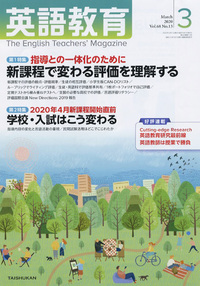
アメリカ合衆国とイギリスを国として比較した場合,典型的なイメージとしては,アメリカは新しいもの好きの革新主義,イギリスは古いもの好きの保守主義といったところでしょう.しかし,アメリカ英語とイギリス英語を英語変種として比較した場合,上のステレオタイプはしばしば当てはまりません.むしろアメリカ英語のほうが古い語法をよく保持していたり,イギリス英語のほうが新しい言葉使いを発達させていたりということが,よくあります.もちろんステレオタイプ通りにアメリカ英語が革新的で,イギリス英語が保守的であるという事例も少なくないことは事実なので,全体としていえば,両英語変種は革新・保守という軸でことさらに対立させるよりも,単に様々な点で互いに異なっていると表現したほうが妥当のように思われます.英米変種の異なり方には,表面的に眺めるだけでは見えてこない,歴史的な様々なパターンがあったのです.
今回の連載記事では主に発音と綴字の英米差に焦点を当て,アメリカへの移民のタイミングやアメリカ人ノア・ウェブスターによる綴字改革といった社会的な要因が,いかにして変種間の差異をもたらしたかを紹介しました.なぜアメリカ英語では car, four, star などの r が独特の巻き舌で発音されるのに,イギリス英語では子音として発音されないのか.なぜ color (米)/colour (英),center/centre, traveling/travelling のような綴字の差が存在するのか.いずれの問題も,英語の歴史をたどることによって理由が明らかになります.
今回の記事で英語の英米差に関心をもった方は,本ブログからの以下の記事(および ame_bre の全記事)もお読みください.
・ 「#357. American English or British English?」 ([2010-04-19-1])
・ 「#359. American English or British English? の解答」 ([2010-04-21-1])
・ 「#1343. 英語の英米差を整理(主として発音と語彙)」 ([2012-12-30-1])
・ 「#244. 綴字の英米差のリスト」 ([2009-12-27-1])
・ 「#240. 綴字の英米差は大きいか小さいか?」 ([2009-12-23-1])
・ 「#312. 文法の英米差」 ([2010-03-05-1])
・ 「#315. イギリス英語はアメリカ英語に比べて保守的か」 ([2010-03-08-1])
・ 「#1304. アメリカ英語の「保守性」」 ([2012-11-21-1])
・ 「#1266. アメリカ英語に "colonial lag" はあるか (1)」 ([2012-10-14-1])
・ 「#1267. アメリカ英語に "colonial lag" はあるか (2)」 ([2012-10-15-1])
・ 「#1268. アメリカ英語に "colonial lag" はあるか (3)」 ([2012-10-16-1])
・ 「#468. アメリカ語を作ろうとした Webster」 ([2010-08-08-1])
・ 「#3089. 「アメリカ独立戦争と英語」のまとめスライド」 ([2017-10-11-1])
・ 「#2916. 連載第4回「イギリス英語の autumn とアメリカ英語の fall --- 複線的思考のすすめ」」 ([2017-04-21-1])
・ 「#2925. autumn vs fall, zed vs zee」 ([2017-04-30-1])
12回の連載を読んでいただいた読者の方々には,1年間お付き合いいただきましてありがとうございます.連載を通じて主張してきたことは,現在の英語は歴史的に英語が変化してきた結果の姿である,ということです.もっと正確にいえば,英語を使用する社会全体が歴史的に英語を変化させてきた結果の姿である,ということです.英語史を通じて新しい英語の見方のツボが伝わったでしょうか.「英語史のツボ」は,本ブログでも引き続き追求していく予定です.今後ともよろしくお願い致します.
・ 「英語指導の引き出しを増やす 英語史のツボ 第12回 なぜアメリカ英語はイギリス英語と異なっているのか」『英語教育』2020年3月号,大修館書店,2020年2月14日.62--63頁.
2020-01-27 Mon
■ #3927. 英語におけるローマン・アルファベット一式の歴史的変遷 [alphabet][grapheme][oe][link]
Cook (166) に,"Comparing older letter forms with Modern English" と題する表がある.大雑把ではあるが,英語のローマン・アルファベット一式を構成する文字の目録の変遷がよくまとまっているので,以下に再現する.
| Shared letters | Extra letters | Variants of another letter | Rare letters | Unused letters | |
| Old English (tenth century) | b c d f h l m n p r s t | ȝ ƿ þ ð æ | x (used for -cs occasionally æx) | k q z | g j v |
| a e i o u y | |||||
| Middle English (fourteenth century) | b c d f g h k l m n p q r s t w x z | ȝ þ (later th) | u (medial v) | ||
| a e i o u y | j (initial i) | ||||
| Early Modern English (1500--1700) | b c d f g h k l m n p q r s t w x z | u/v (till 1630) | |||
| a e i o u y | j/i (till 1640) | ||||
| 'long' ʃ | |||||
| Modern English (1700--present-day) | b c d f g h j k l m n p q r s t v w x z | ||||
| a e i o u y |
本ブログでも各文字に関する話題はいろいろと取り上げてきた.g, v など各文字自身のタグが付けられている記事も多いので,ぜひご一読を.以下にもいくつかピックアップしておきたい.
・ 「#3038. 古英語アルファベットは27文字」 ([2017-08-21-1])
・ 「#3049. 近代英語期でもアルファベットはまだ26文字ではなかった?」 ([2017-09-01-1])
・ 「#1824. <C> と <G> の分化」 ([2014-04-25-1])
・ 「#1650. 文字素としての j の独立」 ([2013-11-02-1])
・ 「#1914. <g> の仲間たち」 ([2014-07-24-1])
・ 「#2498. yogh の文字」 ([2016-02-28-1])
・ 「#584. long <s> と graphemics」 ([2010-12-02-1])
・ 「#2997. 1800年を境に印刷から消えた long <s>」 ([2017-07-11-1])
・ 「#3875. 手書きでは19世紀末までかろうじて生き残っていた long <s>」 ([2019-12-06-1])
・ 「#373. <u> と <v> の分化 (1)」 ([2010-05-05-1])
・ 「#374. <u> と <v> の分化 (2)」 ([2010-05-06-1])
・ 「#3391. Johnson にも悩ましかった i/j, u/v の「四つ文字」問題」 ([2018-08-09-1])
・ 「#2411. 英語の <w> = "double u" とフランス語の <w> = "double v"」 ([2015-12-03-1])
・ 「#2280. <x> の話」 ([2015-07-25-1])
・ 「#1830. Y の名称」 ([2014-05-01-1])
・ 「#446. しぶとく生き残ってきた <z>」 ([2010-07-17-1])
・ Cook, Vivian. The English Writing System. London: Hodder Education, 2004.
[ 固定リンク | 印刷用ページ ]
2020-01-17 Fri
■ #3917. 『英語教育』の連載第11回「なぜ英語には省略語が多いのか」 [rensai][notice][sobokunagimon][shortening][abbreviation][blend][acronym][compound][compounding][derivation][derivative][conversion][disguised_compound][word_formation][lexicology][borrowing][link]
1月14日に,『英語教育』(大修館書店)の2月号が発売されました.英語史連載「英語指導の引き出しを増やす 英語史のツボ」の第11回となる今回は「なぜ英語には省略語が多いのか」という話題です.
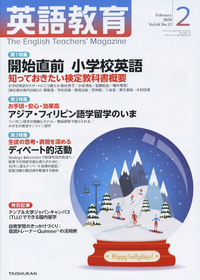
今回の連載記事は,タイトルとしては省略語に焦点を当てているようにみえますが,実際には英語の語形成史の概観を目指しています.複合 (compounding) や派生 (derivation) などを多用した古英語.他言語から語を借用 (borrowing) することに目覚めた中英語.品詞転換 (conversion) あるいはゼロ派生 (zero-derivation) と呼ばれる玄人的な技を覚えた後期中英語.そして,近現代英語にかけて台頭してきた省略 (abbreviation) や短縮 (shortening) です.
英語史を通じて様々に発展してきたこれらの語形成 (word_formation) の流れを,四則計算になぞらえて大雑把にまとめると,(1) 足し算・掛け算の古英語,(2) ゼロの後期中英語,(3) 引き算・割り算の近現代英語となります.現代は省略や短縮が繁栄している引き算・割り算の時代ということになります.
英語の語形成史を上記のように四則計算になぞらえて大づかみして示したのは,今回の連載記事が初めてです.荒削りではありますが,少なくとも英語史の流れを頭に入れる方法の1つとしては有効だろうと思っています.ぜひ原文をお読みいただければと思います.
省略や短縮について,連載記事と関連するブログ記事へリンクを集めてみました.あわせてご一読ください.
・ 「#631. blending の拡大」 ([2011-01-18-1])
・ 「#876. 現代英語におけるかばん語の生産性は本当に高いか?」 ([2011-09-20-1])
・ 「#887. acronym の分類」 ([2011-10-01-1])
・ 「#889. acronym の20世紀」 ([2011-10-03-1])
・ 「#893. shortening の分類 (1)」 ([2011-10-07-1])
・ 「#894. shortening の分類 (2)」 ([2011-10-08-1])
・ 「#1946. 機能的な観点からみる短化」 ([2014-08-25-1])
・ 「#2624. Brexit, Breget, Regrexit」 ([2016-07-03-1])
・ 「#2982. 現代日本語に溢れるアルファベット頭字語」 ([2017-06-26-1])
・ 「#3075. 略語と暗号」 ([2017-09-27-1])
・ 「#3329. なぜ現代は省略(語)が多いのか?」 ([2018-06-08-1])
・ 「#3708. 省略・短縮は形態上のみならず機能上の問題解決法である」 ([2019-06-22-1])
・ 「英語指導の引き出しを増やす 英語史のツボ 第11回 なぜ英語には省略語が多いのか」『英語教育』2020年2月号,大修館書店,2020年1月14日.62--63頁.
2020-01-01 Wed
■ #3901. 2019年によく読まれた記事 [link][sobokunagimon][notice]
明けましておめでとうございます.本年も英語史ブログを続けていく予定です.どうぞよろしくお願い申し上げます.
この1年間でどのような記事がよく読まれてきたか,ざっと調べてみました.12月30日付のアクセス・ランキング (access ranking) のトップ500記事をご覧ください.
なぜかトップは「#2227. なぜ <u> で終わる単語がないのか」 ([2015-06-02-1]) という記事でした.その他の最上位の記事は,順位の入れ替えはあるにせよ,いつみてもおよそ固定している感じです.英語史ブログなのに,3位が「#1525. 日本語史の時代区分」 ([2013-06-30-1]) というのは,いつみてもコケそうになります(ただし,私自身は英語史と日本語史の比較対照に,並々ならぬ関心を寄せています).ぜひ専門の方に日本語史ブログを始めていただきたいところです.なお,「#1524. 英語史の時代区分」 ([2013-06-29-1]) は107位です.
昨年より,雑誌『英語教育』(大修館書店)にて英語の素朴な疑問を話題にする連載記事「英語指導の引き出しを増やす 英語史のツボ」を執筆する機会をいただいていることもあり,2019年は本ブログでも意識して素朴な疑問を取り上げてきました.先のトップ500記事のなかから昨年中に執筆したものを集めると,以下のとおりです.素朴な疑問に関する記事がよく読まれたことが分かります.
ということで,今年も素朴な疑問をなるべく多く取り上げていきたいと思います.関連して英語に関する素朴な疑問集もどうぞ.
- 「#3677. 英語に関する「素朴な疑問」を集めてみました」 (1617)
- 「#3717. 音声学と音韻論はどう違うのですか?」 (1107)
- 「#3611. なぜ He is to blame. は He is to be blamed. とならないのか?」 (664)
- 「#3714. 活字体(ブロック体)と筆記体」 (647)
- 「#3575. イギリスの貨幣制度の略史」 (616)
- 「#3576. 黒人英語 (= AAVE) の言語的特徴 --- 発音」 (565)
- 「#3648. なんで *He cans swim. のように助動詞には3単現の -s がつかないのですか?」 (407)
- 「#3593. アングロサクソンは本当にケルトを一掃したのか?」 (394)
- 「#3694. 朝尾 幸次郎(著)『英語の歴史から考える英文法の「なぜ」』」 (369)
- 「#3604. なぜ The house is building. で「家は建築中である」という意味になるのか?」 (365)
- 「#3676. 英語コーパスの使い方」 (365)
- 「#3670.『英語教育』の連載第3回「なぜ不規則な動詞活用があるのか」」 (344)
- 「#3726. Just The Word --- 英作文の強力なお供」 (339)
- 「#3654. x で始まる英単語が少ないのはなぜですか?」 (333)
- 「#3653. Ebonics 論争」 (328)
- 「#3546. 英語史や語源から英単語を学びたいなら,これが基本知識」 (327)
- 「#3663. 細江逸記『英文法汎論』 --- 歴史的な観点からの現代英文法書」 (323)
- 「#3647. 船や国名を受ける she は古英語にあった文法性の名残ですか?」 (302)
- 「#3696. ボキャビルのための「最も役に立つ25の語のパーツ」」 (289)
- 「#3566. 2018年度,英語史の授業を通じて何を学びましたか?」 (285)
- 「#3719. 日本語は開音節言語,英語は閉音節言語」 (280)
- 「#3542. 『CNN English Express』2月号に拙論の英語史特集が掲載されました」 (275)
- 「#3680. 『ケルズの書』がオンラインに」 (266)
- 「#3831. なぜ英語には冠詞があるのですか?」 (261)
- 「#3606. 講座「北欧ヴァイキングと英語」」 (255)
- 「#3669. ゼミのグループ研究のための取っ掛かり書誌」 (246)
- 「#3692. 英語には過去時制と非過去時制の2つしかない!?」 (226)
2019-12-31 Tue
■ #3900. 英語史の分野の学術論文でよく使われる MLA Style [site][link][hel_education][bibliography][sotsuron]
いよいよ2019年も終わりですが,この時期は卒論を始めとする学位論文の提出期限の前後の時期でもあります.切羽詰まっている学生もいることと思いますが,論文の書式については時間を割いて揃えましょう.
英語学術論文の書式には様々な種類がありますが,本ブログの主題である英語史や,その隣接分野である文学などでよく用いられるものに Modern Language Association (MLA) による MLA Style があります.MLA Style にも版があり,現行版は2016年に改訂された第8版です.本ブログでも,各記事での引用や参考文献などは,原則として MLA Style に準拠しています(ただし,古い版に基づいており現行版とは多少異なっているのであしからず.本ブログ全体の参考文献リストもご参照ください).
MLA Style は正式には1冊の本として出版されていますが,オンラインのリソースも多々あるので,以下に参照に便利なリンクを張っておきます.
・ The MLA Style Center の参考文献表についてのクイック・ガイド
・ MLA Formatting and Style Guide --- Purdue Writing Lab
・ The Complete Guide to MLA & Citations
・ MLA Format: Everything You Need to Know Here
学術研究において参考文献リストの整理は重要です.本音として「面倒くさい」のも事実なのですが,実はそのような面倒くささを軽減してくれるのが書式でありマニュアルです.つまり,学術研究上の文房具の1つです.英語論文を執筆する(予定の)学生は,MLA Style でなくとも,いずれかの書式をしっかり身につけておきましょう.
2019-12-17 Tue
■ #3886. 話しことばと書きことば (6) [writing][medium][punctuation][link]
話しことばと書きことばの比較・対照について,以下の記事で取り上げてきた.
・ 「#230. 話しことばと書きことばの対立は絶対的か?」 ([2009-12-13-1])
・ 「#748. 話し言葉と書き言葉」 ([2011-05-15-1])
・ 「#849. 話し言葉と書き言葉 (2)」 ([2011-08-24-1])
・ 「#1001. 話しことばと書きことば (3)」 ([2012-01-23-1])
・ 「#1665. 話しことばと書きことば (4)」 ([2013-11-17-1])
・ 「#2301. 話し言葉と書き言葉をつなぐスペクトル」 ([2015-08-15-1])
・ 「#3274. 話し言葉と書き言葉 (5)」 ([2018-04-14-1])
・ 「#3411. 話し言葉,書き言葉,口語(体),文語(体)」 ([2018-08-29-1])
・ 「#3799. 話し言葉,書き言葉,口語(体),文語(体) (2)」 ([2019-09-21-1])
・ 「#2535. 記号 (sign) の種類 --- 伝える手段による分類」 ([2016-04-05-1])
この問題を論じる際に重要なのは,両者が言語の媒体 (medium) として「物理的に」異なるものであるという基本的な認識である.話しことばは聴覚に訴えかける音を利用し,書きことばは視覚に訴えかける記号を利用する.この基本的な違いから,ほぼすべての重要な違いが生み出されるということだ.つまり,一見言語学的な問題にみえるが,実のところ物理学や生理学の問題に帰着するといえる (cf. 「#1063. 人間の言語はなぜ音声に依存しているのか (1)」 ([2012-03-25-1]),「#1064. 人間の言語はなぜ音声に依存しているのか (2)」 ([2012-03-26-1]),「#1065. 第三者的な客体としての音声言語の特徴」 ([2012-03-27-1])).
Cook (38) は両媒体の特徴を,次のように簡潔にまとめている.
| Speech is spoken sounds | Writing is written symbols |
|---|---|
| Speech is fleeting | Writing is permanent |
| Speech is linear in time | Writing can be consulted, regardless of time |
| Speech is processed 'on-line' | Writing is stored 'off-line' |
| Speech can be produced and comprehended at around 150 words per minute | Writing can be read at up to 350 words per minutes |
| Speech is spontaneous first-draft | Writing is carefully worked, final-draft |
| Speech is linked to a definite shared context | Writing has an indefinite non-shared context |
| Speech attributes definite roles to the listener | Writing attributes indefinite roles to the reader |
| Speech can use sound features such as intonation | Wiring can use written features such as punctuation |
このような違いがあるので,当然ながら話しことばでしか表現できないこと,逆に書きことばでしか表現できないことがある.後者の例としては,inn (名詞)と in (前置詞)の区別,art (普通名詞)と Art (固有名詞)の区別,各種の句読記号 (punctuation) や {;-) のような emoticon も,話し言葉には対応するものがない(cf. 「#808. smileys or emoticons」 ([2011-07-14-1])).
最近では,書き言葉は話し言葉の写しにすぎないという従来の見方から脱した,書き言葉の自立性を主張する議論もちらほらと見聞きするようになってきた.以下の記事を参照されたい.
・ 「#1829. 書き言葉テクストの3つの機能」 ([2014-04-30-1])
・ 「#2339. 書き言葉の自立性に関する Vachek の議論 (1)」 ([2015-09-22-1])
・ 「#2340. 書き言葉の自立性に関する Vachek の議論 (2)」 ([2015-09-23-1])
・ 「#2431. 書き言葉の自立性に関する Bolinger の議論」 ([2015-12-23-1])
・ 「#2508. 書き言葉の自立性に関する Samuels の議論」 ([2016-03-09-1])
・ 「#2819. 話し言葉中心主義から脱しつつある言語学」 ([2017-01-14-1])
・ Cook, Vivian. The English Writing System. London: Hodder Education, 2004.
2019-12-16 Mon
■ #3885. 『英語教育』の連載第10回「なぜ英語には類義語が多いのか」 [rensai][notice][lexicology][synonym][loan_word][borrowing][french][latin][lexical_stratification][sobokunagimon][link]
12月13日に,『英語教育』(大修館書店)の1月号が発売されました.英語史連載「英語指導の引き出しを増やす 英語史のツボ」の第10回となる今回は「なぜ英語には類義語が多いのか」という話題を扱っています.
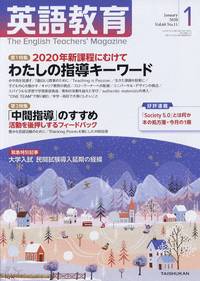
英語には「上がる」を意味する動詞として rise,mount,ascend などの類義語があります.「活発な」を表わす形容詞にも lively, vivacious, animated などがあります.名詞「人々」についても folk, people, population などが挙がります.これらは「英語語彙の3層構造」の典型例であり,英語がたどってきた言語接触の歴史の遺産というべきものです.本連載記事では,英語語彙に特徴的な豊かな類義語の存在が,1066年のノルマン征服と16世紀のルネサンスのたまものであり,さらに驚くことに,日本語にもちょうど似たような歴史的事情があることを指摘しています.
「英語語彙の3層構造」については,本ブログでも関連する話題を多く取り上げてきました.以下をご覧ください.
・ 「#334. 英語語彙の三層構造」 ([2010-03-27-1])
・ 「#1296. 三層構造の例を追加」 ([2012-11-13-1])
・ 「#1960. 英語語彙のピラミッド構造」 ([2014-09-08-1])
・ 「#2072. 英語語彙の三層構造の是非」 ([2014-12-29-1])
・ 「#2279. 英語語彙の逆転二層構造」 ([2015-07-24-1])
・ 「#2643. 英語語彙の三層構造の神話?」 ([2016-07-22-1])
・ 「#387. trisociation と triset」 ([2010-05-19-1])
・ 「#2977. 連載第6回「なぜ英語語彙に3層構造があるのか? --- ルネサンス期のラテン語かぶれとインク壺語論争」」 ([2017-06-21-1])
・ 「#3374. 「示相語彙」」 ([2018-07-23-1])
・ 「#335. 日本語語彙の三層構造」 ([2010-03-28-1])
・ 「#3357. 日本語語彙の三層構造 (2)」 ([2018-07-06-1])
・ 「#1630. インク壺語,カタカナ語,チンプン漢語」 ([2013-10-13-1])
・ 「#1526. 英語と日本語の語彙史対照表」 ([2013-07-01-1])
・ 堀田 隆一 「なぜ英語には類義語が多いのか」『英語教育』2020年1月号,大修館書店,2019年12月13日.62--63頁.
2019-11-21 Thu
■ #3860. 京大先生シアター,家入葉子先生による「英語史 ことばが変化し続けることの意味」 [hel_education][notice][link]
京大先生シアターに,京都大学文学研究科(文献文化学専攻英語学英米文学専修)の家入葉子先生が出演しています.「英語史 ことばが変化し続けることの意味」と題した3分弱の動画です.こちらよりどうぞ.
英語に限らず,すべての言語が過去に変化してきましたし,そして現在も変化しています.言葉は常に変化するものです.家入先生は,動画のなかで do 迂言法 (do-periphrasis) や make の使役構文 (causative) などの話題に触れながら「現代に引きつけた英語史」という視点を押し出されています.英語史の教育・研究において,この視点はますます重要になってくることと私も考えています.
家入先生のウェブサイトは,英語史関連のコンテンツも充実しています.リンクも様々に張られていますので,英語史の学びに役立ちます.
2019-11-18 Mon
■ #3857. 『英語教育』の連載第9回「なぜ英語のスペリングには黙字が多いのか」 [rensai][notice][silent_letter][consonant][spelling][spelling_pronunciation_gap][sound_change][phonetics][etymological_respelling][latin][standardisation][sobokunagimon][link]
11月14日に,『英語教育』(大修館書店)の12月号が発売されました.英語史連載「英語指導の引き出しを増やす 英語史のツボ」の第9回となる今回の話題は「なぜ英語のスペリングには黙字が多いのか」です.
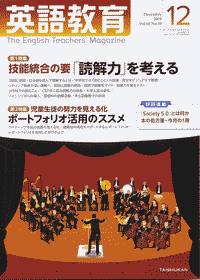
黙字 (silent_letter) というのは,climb, night, doubt, listen, psychology, autumn などのように,スペリング上は書かれているのに,対応する発音がないものをいいます.英単語のスペリングをくまなく探すと,実に a から z までのすべての文字について黙字として用いられている例が挙げられるともいわれ,英語学習者にとっては実に身近な問題なのです.
今回の記事では,黙字というものが最初から存在したわけではなく,あくまで歴史のなかで生じてきた現象であること,しかも個々の黙字の事例は異なる時代に異なる要因で生じてきたものであることを易しく紹介しました.
連載記事を読んで黙字の歴史的背景の概観をつかんでおくと,本ブログで書いてきた次のような話題を,英語史のなかに正確に位置づけながら理解することができるはずです.
・ 「#2518. 子音字の黙字」 ([2016-03-19-1])
・ 「#1290. 黙字と黙字をもたらした音韻消失等の一覧」 ([2012-11-07-1])
・ 「#34. thumb の綴りと発音」 ([2009-06-01-1])
・ 「#724. thumb の綴りと発音 (2)」 ([2011-04-21-1])
・ 「#1902. 綴字の標準化における時間上,空間上の皮肉」 ([2014-07-12-1])
・ 「#1195. <gh> = /f/ の対応」 ([2012-08-04-1])
・ 「#2590. <gh> を含む単語についての統計」 ([2016-05-30-1])
・ 「#3333. なぜ doubt の綴字には発音しない b があるのか?」 ([2018-06-12-1])
・ 「#116. 語源かぶれの綴り字 --- etymological respelling」 ([2009-08-21-1])
・ 「#1187. etymological respelling の具体例」 ([2012-07-27-1])
・ 「#579. aisle --- なぜこの綴字と発音か」 ([2010-11-27-1])
・ 「#580. island --- なぜこの綴字と発音か」 ([2010-11-28-1])
・ 「#1156. admiral の <d>」 ([2012-06-26-1])
・ 「#3492. address の <dd> について (1)」 ([2018-11-18-1])
・ 「#3493. address の <dd> について (2)」 ([2018-11-19-1])
・ 堀田 隆一 「なぜ英語のスペリングには黙字が多いのか」『英語教育』2019年12月号,大修館書店,2019年11月14日.62--63頁.
2019-11-06 Wed
■ #3845. 講座「英語の歴史と語源」の第5回「キリスト教の伝来」を終えました [asacul][notice][slide][link][christianity][alphabet][latin][loan_word][bible][religion]
「#3833. 講座「英語の歴史と語源」の第5回「キリスト教の伝来」のご案内」 ([2019-10-25-1]) で案内した朝日カルチャーセンター新宿教室の講座を11月2日(土)に終えました.今回も大勢の方に参加していただき,白熱した質疑応答が繰り広げられました.多岐にわたるご指摘やコメントをいただき,たいへん充実した会となりました.
講座で用いたスライド資料をこちらに置いておきますので,復習等にご利用ください.スライドの各ページへのリンクも張っておきます.
1. 英語の歴史と語源・5 「キリスト教の伝来」
2. 第5回 キリスト教の伝来
3. 目次
4. 1. イングランドのキリスト教化
5. 古英語期まで(?1066年)のキリスト教に関する略年表
6. 2. ローマ字の採用
7. ルーン文字とは?
8. 現存する最古の英文はルーン文字で書かれていた
9. ルーン文字の遺産
10. 古英語のアルファベット
11. 古英語文学の開花
12. 3. ラテン語の借用
13. 古英語語彙におけるラテン借用語比率
14. キリスト教化以前と以後のラテン借用
15. 4. 聖書翻訳の伝統
16. 5. 宗教と言語
17. 外来宗教が英語と日本語に与えた言語的影響の比較
18. 日本語における宗教語彙
19. まとめ
20. 補遺:「主の祈り」の各時代のヴァージョン
21. 参考文献
次回の第6回は少し先の2020年3月21日(土)の15:15?18:30となります.「ヴァイキングの侵攻」と題して英語史上の最大の異変に迫る予定です.
2019-10-25 Fri
■ #3833. 講座「英語の歴史と語源」の第5回「キリスト教の伝来」のご案内 [asacul][notice][christianity][anglo-saxon][link]
来週末の11月2日(土)の15:15?18:30に,朝日カルチャーセンター新宿教室にて「英語の歴史と語源・5 キリスト教の伝来」と題する講演を行ないます.ご関心のある方は,こちらよりお申し込みください.趣旨は以下の通りです.
6世紀以降,英語話者であるングロサクソン人はキリスト教を受け入れ,大陸文化の影響に大いにさらされることになりました.言語的な影響も著しく,英語はラテン語との接触を通じて2つの激震を経験しました.(1) ローマ字の採用と (2) キリスト教用語を中心とするラテン単語の借用です.これは,後のイングランドと英語の歴史を規定することになる大事件でした.今回は,このキリスト教伝来の英語史上の意義について,ほぼ同時代の日本における仏教伝来の日本語史的意義とも比較・対照しながら,多面的に議論していきます.
合わせて,英語史における聖書翻訳の伝統にも触れる予定です.
以下,予習のために,関連する話題を扱った記事をいくつか紹介しておきます.
・ 「#2485. 文字と宗教」 ([2016-02-15-1])
・ 「#3193. 古英語期の主要な出来事の年表」 ([2018-01-23-1])
・ 「#3038. 古英語アルファベットは27文字」 ([2017-08-21-1])
・ 「#3199. 講座「スペリングでたどる英語の歴史」の第2回「英語初のアルファベット表記 --- 古英語のスペリング」」 ([2018-01-29-1])
・ 「#1437. 古英語期以前に借用されたラテン語の例」 ([2013-04-03-1])
・ 「#32. 古英語期に借用されたラテン語」 ([2009-05-30-1])
・ 「#3787. 650年辺りを境とする,その前後のラテン借用語の特質」 ([2019-09-09-1])
・ 「#3790. 650年以前のラテン借用語の一覧」 ([2019-09-12-1])
・ 「#1619. なぜ deus が借用されず God が保たれたのか」 ([2013-10-02-1])
・ 「#1439. 聖書に由来する表現集」 ([2013-04-05-1])
・ 「#296. 外来宗教が英語と日本語に与えた言語的影響」 ([2010-02-17-1])
・ 「#1869. 日本語における仏教語彙」 ([2014-06-09-1])
・ 「#3382. 神様を「大日」,マリアを「観音」,パライソを「極楽」と訳したアンジロー」 ([2018-07-31-1])
・ 「#1427. 主要な英訳聖書に関する年表」 ([2013-03-24-1])
・ 「#1709. 主要英訳聖書年表」 ([2013-12-31-1])
2019-10-24 Thu
■ #3832. 講座「英語の歴史と語源」の第4回「ゲルマン民族の大移動」を終えました [asacul][notice][slide][link][anglo-saxon]
「#3806. 講座「英語の歴史と語源」の第4回「ゲルマン民族の大移動」のご案内」 ([2019-09-28-1]) で案内した朝日カルチャーセンター新宿教室の講座を10月20日(日)に終えました(当初の予定は10月12日(土)でしたが,台風19号により延期しました).今回も過去3回とともに,質疑応答を含め参加者の方々と活発な交流の時間をもつことができました.
講座で用いたスライド資料はこちらに置いておきます.自由にご参照ください.以下に,スライドの各ページへのリンクも貼っておきます.
1. 英語の歴史と語源・4 「ゲルマン民族の大移動」
2. 第4回 ゲルマン民族の大移動
3. 目次
4. 1. ゲルマン民族の大移動とアングロ・サクソンの渡来
5. ゲルマン語派とゲルマン諸民族
6. 「アングロ・サクソン人」とは誰?
7. 「イングランド」「イングリッシュ」「アングロ・サクソン」の名称
8. 2. 古英語の語彙
9. 古英語の語形成の特徴
10. 複合 (compounding) と派生 (derivation)
11. 隠喩的複合語 (kenning)
12. 3. 現代に残る古英語の語彙的遺産
13. 古英語語彙だけで構成された現代英語文
14. 偽装複合語 (disguised compound)
15. まとめ
16. 参考文献
17. 補遺:Anglo-Saxon Chronicle の449年の記述
次回,第5回の講座「キリスト教の伝来」は,11月2日(土)の15:15?18:30に予定されています.ご関心のある方は,是非こちらよりお申し込みください.
2019-10-14 Mon
■ #3822. 『英語教育』の連載第8回「なぜ bus, bull, busy, bury の母音は互いに異なるのか」 [rensai][notice][vowel][spelling][spelling_pronunciation_gap][me_dialect][sound_change][phonetics][standardisation][sobokunagimon][link]
10月12日に,『英語教育』(大修館書店)の11月号が発売されました.英語史連載「英語指導の引き出しを増やす 英語史のツボ」の第8回となる今回の話題は「なぜ bus, bull, busy, bury の母音は互いに異なるのか」です.
英語はスペリングと発音の関係がストレートではないといわれますが,それはとりわけ母音について当てはまります.たとえば,mat と mate では同じ <a> のスペリングを用いていながら,前者は /æ/,後者は /eɪ/ と発音されるように,1つのスペリングに対して2つの発音が対応している例はざらにあります.逆に同じ発音でも異なるスペリングで綴られることは,meat, meet, mete などの同音異綴語を思い起こせばわかります.
今回の記事では <u> の母音字に注目し,それがどんな母音に対応し得るかを考えてみました.具体的には bus /bʌs/, bull /bʊl/, busy /ˈbɪzi/, bury /ˈbɛri/ という単語を例にとり,いかにしてそのような「理不尽な」スペリングと発音の対応が生じてきてしまったのかを,英語史の観点から解説します.記事にも書いたように「現在のスペリングは,異なる時代に異なる要因が作用し,秩序が継続的に崩壊してきた結果の姿」です.背景には,あっと驚く理由がありました.その謎解きをお楽しみください.
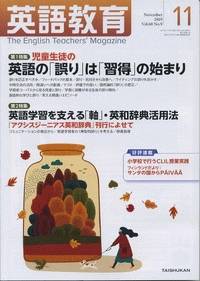
今回の連載記事と関連して,本ブログの以下の記事もご覧ください.
・ 「#1866. put と but の母音」 ([2014-06-06-1])
・ 「#562. busy の綴字と発音」 ([2010-11-10-1])
・ 「#570. bury の母音の方言分布」 ([2010-11-18-1])
・ 「#1297. does, done の母音」 ([2012-11-14-1])
・ 「#563. Chaucer の merry」 ([2010-11-11-1])
・ 堀田 隆一 「英語指導の引き出しを増やす 英語史のツボ 第8回 なぜ bus, bull, busy, bury の母音はそれぞれ異なるのか」『英語教育』2019年11月号,大修館書店,2019年10月12日.62--63頁.
2019-09-14 Sat
■ #3792. 講座「英語の歴史と語源」の第3回「ローマ帝国の植民地」を終えました [asacul][notice][latin][roman_britain][etymology][slide][link]
「#3781. 講座「英語の歴史と語源」の第3回「ローマ帝国の植民地」のご案内」 ([2019-09-03-1]) で紹介したとおり,9月7日(土)15:15?18:30に朝日カルチャーセンター新宿教室にて「英語の歴史と語源・3 ローマ帝国の植民地」と題する講演を行ないました.過去2回と同様,大勢の方々に参加いただきまして,ありがとうございました.核心を突いた質問も多数飛び出し,私自身もおおいに勉強になりました. *
今回は,(1) ローマン・ブリテンの時代背景を紹介した後,(2) 同時代にはまだ大陸にあった英語とラテン語の「馴れ初め」及びその後の「腐れ縁」について概説し,(3) 最初期のラテン借用語が意外にも日常的な性格を示す点に注目しました.
特に3点目については,従来あまり英語史で注目されてこなかったように思われますので,具体例を挙げながら力説しました.ラテン借用語といえば,語彙の3層構造のトップに君臨する語彙として,お高く,お堅く,近寄りがたいイメージをもってとらえられることが多いのですが,こと最初期に借用されたものには現代でも常用される普通の語が少なくありません.ラテン語に関するステレオタイプが打ち砕かれることと思います.
講座で用いたスライド資料をこちらに置いておきます.本ブログの関連記事へのリンク集にもなっていますので,復習などにお役立てください.
次回の第4回は10月12日(土)15:15?18:30に「英語の歴史と語源・4 ゲルマン民族の大移動」と題して,いよいよ「英語の始まり」についてお話しする予定です.
1. 英語の歴史と語源・3 「ローマ帝国の植民地」
2. 第3回 ローマ帝国の植民地
3. 目次
4. 1. ローマン・ブリテンの時代
5. ローマン・ブリテンの地図
6. ローマン・ブリテンの言語状況 (1) --- 複雑なマルチリンガル社会
7. ローマン・ブリテンの言語状況 (2) --- ガリアとの比較
8. ローマ軍の残した -chester, -caster, -cester の地名
9. 多くのラテン地名が後にアングロ・サクソン人によって捨てられた理由
10. 2. ラテン語との「腐れ縁」とその「馴れ初め」
11. ラテン語との「腐れ縁」の概観
12. 現代英語におけるラテン語の位置づけ
13. 3. 最初期のラテン借用語の意外な日常性
14. 行為者接尾辞 -er と -ster も最初期のラテン借用要素?
15. 古英語語彙におけるラテン借用語比率
16. 借用の経路 --- ラテン語,ケルト語,古英語の関係
17. cheap の由来
18. pound (?) の由来
19. Saturday とその他の曜日名の由来
20. まとめ
21. 参考文献
Powered by WinChalow1.0rc4 based on chalow